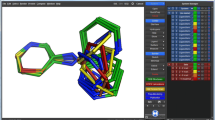Abstract
Computer-aided drug design encompasses a wide variety of tools and techniques, and can be implemented with a range of organisational structures and focus in different organisations. Here we outline the computational chemistry skills within Sygnature Discovery, along with the software and hardware at our disposal, and briefly discuss the methods that are not employed and why. The goal of the group is to provide support for design and analysis in order to improve the quality of compounds synthesised and reduce the timelines of drug discovery projects, and we reveal how this is achieved at Sygnature. Impact on medicinal chemistry is vital to demonstrating the value of computational chemistry, and we discuss the approaches taken to influence the list of compounds for synthesis, and how we recognise success. Finally we touch on some of the areas being developed within the team in order to provide further value to the projects and clients.
Similar content being viewed by others
References
Abagyan RA, Totrov MM, Kuznetsov DN (1994) ICM—a new method for protein modeling and design. Applications to docking and structure prediction from the distorted native conformation. J Comp Chem 15:488–506
Spartan 10 Wavefunction, Inc. Irvine, CA. http://downloads.wavefun.com/Spartan10Manual.pdf
OpenEye Scientific Software, Inc., Santa Fe, NM, www.eyesopen.com (2010)
Michael BR, Nicolas C, Fabian D, Thomas GR, Tobias K, Thorsten M, Peter O, Christoph S, Kilian T, Bernd W (2008) KNIME: the konstanz information miner. In: Christine P, Hans B, Lars S-T, Reinhold D (eds) Proceedings of the 31st Annual Conference of the Gesellschaft für Klassifikation e.V., Albert-Ludwigs-Universität Freiburg, March 7–9, 2007. Data analysis, machine learning and applications, vol V. Springer, Berlin, pp 319-326
The PyMOL Molecular Graphics System, Schrödinger, LLC. https://www.pymol.org/citing
Sander T, Freyss J, von Korff M, Rufener C (2015) DataWarrior: an open-source program for chemistry aware data visualization and analysis. J Chem Inf Model 55(2):460–473
Waterhouse AM, Procter JB, Martin DMA, Clamp M, Barton GJ (2009) Jalview Version 2—a multiple sequence alignment editor and analysis workbench. Bioinformatics 25(9):1189–1191
R Core Team (2016). R: a language and environment for statistical computing. R Foundation for Statistical Computing, Vienna, Austria. https://www.R-project.org/
Free SM, Wilson JW (1964) A mathematical contribution to structure-activity studies. J Med Chem 7(4):395–399
Zwanzig RW (1954) High-temperature equation of state by a perturbation method. I. Nonpolar gases. J Chem Phys 22:1420
RDKit: Open-source cheminformatics; http://www.rdkit.org
Bento AP, Gaulton A, Hersey A, Bellis LJ, Chambers J, Davies M, Krüger FA, Light Y, Mak L, McGlinchey S, Nowotka M, Papadatos G, Santos R, Overington JP (2014) The ChEMBL bioactivity database: an update. Nucleic Acids Res. 42:1083–1090
Fishburn CS (2013) Attenuating attrition. SciBX 6(26):1
Karawajczyk A, Giordanetto F, Benningshof J, Hamza D, Kalliokoski T, Pouwer K, Morgentin R, Nelson A, Mueller G, Piechot A, Tzalis D (2015) Expansion of chemical space for collaborative lead generation and drug discovery: the European Lead Factory Perspective. Drug Discov Today 20(11):1310–1316
Johnstone C, Pairaudeau G, Pettersson JA (2011) Creativity, innovation and lean sigma: a controversial combination? Drug Discov Today 16:50–57
Martin YC (2006) What works and what does not: lessons from experience in a pharmaceutical company. QSAR Comb Sci 25(12):1192–1200
Norrby M, Grebner C, Eriksson J, Boström J (2015) Molecular rift: virtual reality for drug designers. J Chem Inf Model 55(11):2475–2484
Author information
Authors and Affiliations
Corresponding author
Rights and permissions
About this article
Cite this article
St-Gallay, S.A., Sambrook-Smith, C.P. Tools, techniques, organisation and culture of the CADD group at Sygnature Discovery. J Comput Aided Mol Des 31, 305–308 (2017). https://doi.org/10.1007/s10822-016-9989-x
Received:
Accepted:
Published:
Issue Date:
DOI: https://doi.org/10.1007/s10822-016-9989-x




